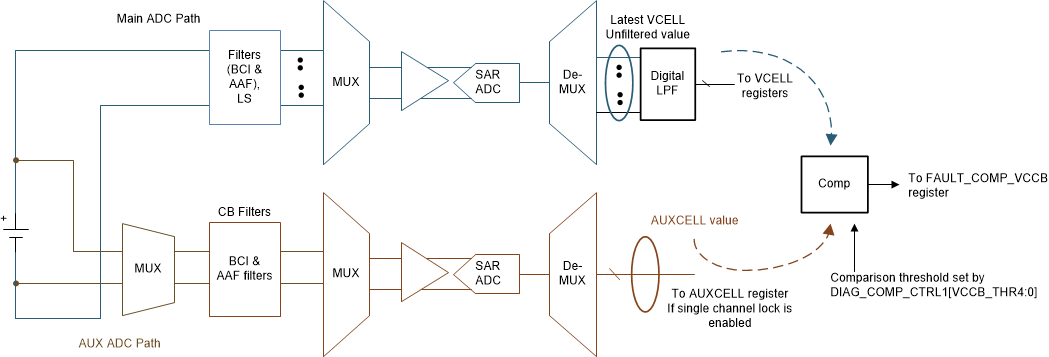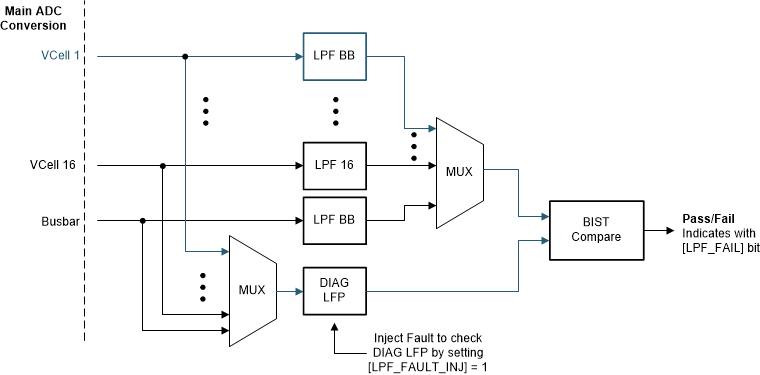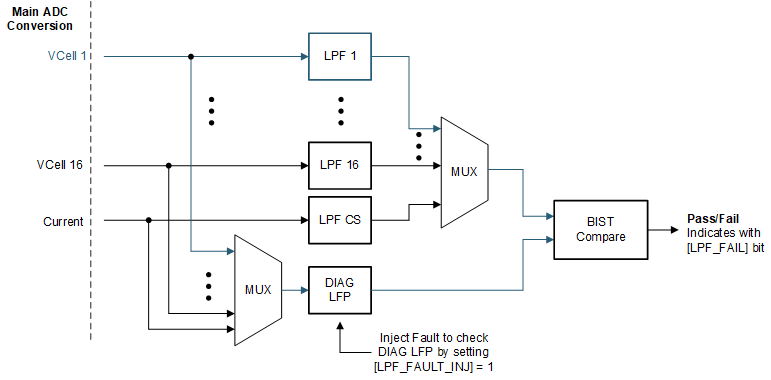ZHCSR27D August 2020 – September 2022 BQ79612-Q1 , BQ79614-Q1 , BQ79616-Q1
PRODUCTION DATA
- 1 特性
- 2 应用
- 3 说明
- 4 Revision History
- 5 说明(续)
- 6 Device Comparison Table
- 7 Pin Configuration and Functions
- 8 Specifications
-
9 Detailed Description
- 9.1 Overview
- 9.2 Functional Block Diagram
- 9.3
Feature Description
- 9.3.1 Power Supplies
- 9.3.2 Measurement System
- 9.3.3 Cell Balancing
- 9.3.4 Integrated Hardware Protectors
- 9.3.5 GPIO Configuration
- 9.3.6
Communication, OTP, Diagnostic Control
- 9.3.6.1
Communication
- 9.3.6.1.1 Serial Interface
- 9.3.6.1.2 Daisy Chain Interface
- 9.3.6.1.3 Start Communication
- 9.3.6.1.4 Communication Timeout
- 9.3.6.1.5 Communication Debug Mode
- 9.3.6.1.6 Multidrop Configuration
- 9.3.6.1.7 SPI Master
- 9.3.6.1.8 SPI Loopback
- 9.3.6.2 Fault Handling
- 9.3.6.3 Nonvolatile Memory
- 9.3.6.4 Diagnostic Control/Status
- 9.3.6.1
Communication
- 9.3.7 Bus Bar Support
- 9.4 Device Functional Modes
- 9.5
Register Maps
- 9.5.1 OTP Shadow Register Summary
- 9.5.2 Read/Write Register Summary
- 9.5.3 Read-Only Register Summary
- 9.5.4
Register Field Descriptions
- 9.5.4.1 Device Addressing Setup
- 9.5.4.2 Device ID and Scratch Pad
- 9.5.4.3
General Configuration and Control
- 9.5.4.3.1 DEV_CONF
- 9.5.4.3.2 ACTIVE_CELL
- 9.5.4.3.3 BBVC_POSN1
- 9.5.4.3.4 BBVC_POSN2
- 9.5.4.3.5 PWR_TRANSIT_CONF
- 9.5.4.3.6 COMM_TIMEOUT_CONF
- 9.5.4.3.7 TX_HOLD_OFF
- 9.5.4.3.8 STACK_RESPONSE
- 9.5.4.3.9 BBP_LOC
- 9.5.4.3.10 COMM_CTRL
- 9.5.4.3.11 CONTROL1
- 9.5.4.3.12 CONTROL2
- 9.5.4.3.13 CUST_CRC_HI
- 9.5.4.3.14 CUST_CRC_LO
- 9.5.4.3.15 CUST_CRC_RSLT_HI
- 9.5.4.3.16 CUST_CRC_RSLT_LO
- 9.5.4.4 Operation Status
- 9.5.4.5 ADC Configuration and Control
- 9.5.4.6
ADC Measurement Results
- 9.5.4.6.1 VCELL16_HI/LO
- 9.5.4.6.2 VCELL15_HI/LO
- 9.5.4.6.3 VCELL14_HI/LO
- 9.5.4.6.4 VCELL13_HI/LO
- 9.5.4.6.5 VCELL12_HI/LO
- 9.5.4.6.6 VCELL11_HI/LO
- 9.5.4.6.7 VCELL10_HI/LO
- 9.5.4.6.8 VCELL9_HI/LO
- 9.5.4.6.9 VCELL8_HI/LO
- 9.5.4.6.10 VCELL7_HI/LO
- 9.5.4.6.11 VCELL6_HI/LO
- 9.5.4.6.12 VCELL5_HI/LO
- 9.5.4.6.13 VCELL4_HI/LO
- 9.5.4.6.14 VCELL3_HI/LO
- 9.5.4.6.15 VCELL2_HI/LO
- 9.5.4.6.16 VCELL1_HI/LO
- 9.5.4.6.17 BUSBAR_HI/LO
- 9.5.4.6.18 TSREF_HI/LO
- 9.5.4.6.19 GPIO1_HI/LO
- 9.5.4.6.20 GPIO2_HI/LO
- 9.5.4.6.21 GPIO3_HI/LO
- 9.5.4.6.22 GPIO4_HI/LO
- 9.5.4.6.23 GPIO5_HI/LO
- 9.5.4.6.24 GPIO6_HI/LO
- 9.5.4.6.25 GPIO7_HI/LO
- 9.5.4.6.26 GPIO8_HI/LO
- 9.5.4.6.27 DIETEMP1_HI/LO
- 9.5.4.6.28 DIETEMP2_HI/LO
- 9.5.4.6.29 AUX_CELL_HI/LO
- 9.5.4.6.30 AUX_GPIO_HI/LO
- 9.5.4.6.31 AUX_BAT_HI/LO
- 9.5.4.6.32 AUX_REFL_HI/LO
- 9.5.4.6.33 AUX_VBG2_HI/LO
- 9.5.4.6.34 AUX_AVAO_REF_HI/LO
- 9.5.4.6.35 AUX_AVDD_REF_HI/LO
- 9.5.4.6.36 AUX_OV_DAC_HI/LO
- 9.5.4.6.37 AUX_UV_DAC_HI/LO
- 9.5.4.6.38 AUX_OT_OTCB_DAC_HI/LO
- 9.5.4.6.39 AUX_UT_DAC_HI/LO
- 9.5.4.6.40 AUX_VCBDONE_DAC_HI/LO
- 9.5.4.6.41 AUX_VCM_HI/LO
- 9.5.4.6.42 REFOVDAC_HI/LO
- 9.5.4.6.43 DIAG_MAIN_HI/LO
- 9.5.4.6.44 DIAG_AUX_HI/LO
- 9.5.4.7 Balancing Configuration, Control and Status
- 9.5.4.8 Protector Configuration and Control
- 9.5.4.9 GPIO Configuration
- 9.5.4.10 SPI Master
- 9.5.4.11 Diagnostic Control
- 9.5.4.12 Fault Configuration and Reset
- 9.5.4.13
Fault Status
- 9.5.4.13.1 FAULT_SUMMARY
- 9.5.4.13.2 FAULT_COMM1
- 9.5.4.13.3 FAULT_COMM2
- 9.5.4.13.4 FAULT_COMM3
- 9.5.4.13.5 FAULT_OTP
- 9.5.4.13.6 FAULT_SYS
- 9.5.4.13.7 FAULT_PROT1
- 9.5.4.13.8 FAULT_PROT2
- 9.5.4.13.9 FAULT_OV1
- 9.5.4.13.10 FAULT_OV2
- 9.5.4.13.11 FAULT_UV1
- 9.5.4.13.12 FAULT_UV2
- 9.5.4.13.13 FAULT_OT
- 9.5.4.13.14 FAULT_UT
- 9.5.4.13.15 FAULT_COMP_GPIO
- 9.5.4.13.16 FAULT_COMP_VCCB1
- 9.5.4.13.17 FAULT_COMP_VCCB2
- 9.5.4.13.18 FAULT_COMP_VCOW1
- 9.5.4.13.19 FAULT_COMP_VCOW2
- 9.5.4.13.20 FAULT_COMP_CBOW1
- 9.5.4.13.21 FAULT_COMP_CBOW2
- 9.5.4.13.22 FAULT_COMP_CBFET1
- 9.5.4.13.23 FAULT_COMP_CBFET2
- 9.5.4.13.24 FAULT_COMP_MISC
- 9.5.4.13.25 FAULT_PWR1
- 9.5.4.13.26 FAULT_PWR2
- 9.5.4.13.27 FAULT_PWR3
- 9.5.4.14
Debug Control and Status
- 9.5.4.14.1 DEBUG_CTRL_UNLOCK
- 9.5.4.14.2 DEBUG_COMM_CTRL1
- 9.5.4.14.3 DEBUG_COMM_CTRL2
- 9.5.4.14.4 DEBUG_COMM_STAT
- 9.5.4.14.5 DEBUG_UART_RC
- 9.5.4.14.6 DEBUG_UART_RR_TR
- 9.5.4.14.7 DEBUG_COMH_BIT
- 9.5.4.14.8 DEBUG_COMH_RC
- 9.5.4.14.9 DEBUG_COMH_RR_TR
- 9.5.4.14.10 DEBUG_COML_BIT
- 9.5.4.14.11 DEBUG_COML_RC
- 9.5.4.14.12 DEBUG_COML_RR_TR
- 9.5.4.14.13 DEBUG_UART_DISCARD
- 9.5.4.14.14 DEBUG_COMH_DISCARD
- 9.5.4.14.15 DEBUG_COML_DISCARD
- 9.5.4.14.16 DEBUG_UART_VALID_HI/LO
- 9.5.4.14.17 DEBUG_COMH_VALID_HI/LO
- 9.5.4.14.18 DEBUG_COML_VALID_HI/LO
- 9.5.4.14.19 DEBUG_OTP_SEC_BLK
- 9.5.4.14.20 DEBUG_OTP_DED_BLK
- 9.5.4.15
OTP Programming Control and Status
- 9.5.4.15.1 OTP_PROG_UNLOCK1A through OTP_PROG_UNLOCK1D
- 9.5.4.15.2 OTP_PROG_UNLOCK2A through OTP_PROG_UNLOCK2D
- 9.5.4.15.3 OTP_PROG_CTRL
- 9.5.4.15.4 OTP_ECC_TEST
- 9.5.4.15.5 OTP_ECC_DATAIN1 through OTP_ECC_DATAIN9
- 9.5.4.15.6 OTP_ECC_DATAOUT1 through OTP_ECC_DATAOUT9
- 9.5.4.15.7 OTP_PROG_STAT
- 9.5.4.15.8 OTP_CUST1_STAT
- 9.5.4.15.9 OTP_CUST2_STAT
-
10Application and Implementation
- 10.1 Application Information
- 10.2
Typical Applications
- 10.2.1
Base
Device Application Circuit
- 10.2.1.1 Design Requirements
- 10.2.1.2 Detailed Design Procedure
- 10.2.1.3 Application Curve
- 10.2.2 Daisy Device Application Circuit
- 10.2.1
Base
Device Application Circuit
- 11Power Supply Recommendations
- 12Layout
- 13Device and Documentation Support
- 14Mechanical, Packaging, and Orderable Information
9.3.6.4.6.1 Cell Voltage Measurement Check
Cell voltage measurement path comparison:
The cell voltage measurement check is performed by comparing the prefiltered measurement result from Main ADC versus measurement result from AUX ADC. To read the compared value measured by Main ADC and AUX ADC, MCU has to set up this diagnostic check to lock on a single channel using [AUX_CELL_SEL] setting and the start this diagnostic check. In this configuration, the compared values from Main ADC and AUX ADC are reported to DIAG_MAIN_HI/LO registers and DIAG_AUX_HI/LO registers respectively.
Both Main and AUX ADC has the same front end filters. This diagnostic time is mostly spend on waiting for the AAF on the AUX ADC path to settle. The [AUX_SETTLE] setting allows the MCU to make trade-off between diagnostic time and noise filter level. Additionally, when AUX ADC starts, by default, AUXCELL slot always align to the Main ADC Cell1 slot. The [AUX_CELL_ALIGN] setting allows MCU to change this alignment to Main ADC Cell8 slot, resulting with less sampling time delta between Main and AUX ADC on the higher channels.
 Figure 9-47 Cell Voltage Measurement
Diagnostic
Figure 9-47 Cell Voltage Measurement
DiagnosticBefore starting the cell voltage measurement comparison, host ensures:
- The desired AUXCELL channels to be tested are configured in the ADC_CTRL2[AUX_CELL_SEL4:0] setting and AUX ADC is enabled and in continuous mode.
- Allow AUX ADC to run through all AUXCELL channels for the device to compensate for common mode error before starting this diagnostic check.
- Main ADC must be enabled and is in continuous mode.
- Select the (VCELL – AUXCELL) comparison threshold through DIAG_COMP_CTRL1[VCCB_THR4:0] setting.
- Select the desired settling time for the AUX CELL channel through ADC_CONF1[AUX_SETTLE1:0].
To start the cell voltage measurement comparison:
- Set DIAG_COMP_CTRL3[COMP_ADC_SEL2:0] = cell voltage measurement check (that is, 0b001) and set [COMP_ADC_GO] = 1.
- For each channel enabled by [AUX_CELL_SEL4:0], the device will compare abs[(VCELL – AUXCELL)] < [VCCB_THR4:0].
- Wait for the comparison to be accomplished, roughly [(number of channel) * (AUXCELL settling time + one round robin cycle time)].
- The cell voltage measurement comparison is completed when ADC_STAT2[DRDY_VCCB] = 1.
Host checks the FAULT_COMP_VCCB1 and FAULT_COMP_VCCB2 registers for the comparison result.
ADC comparison abort conditions:
The device will not start the cell voltage measurement comparison under the invalid conditions listed below. When the comparison is aborted, the FAULT_COMP_MISC[COMP_ADC_ABORT] = 1, [DRDY_AUX_CEL] = 1, [DRDY_VCCB] = 1, and FAULT_COMP_VCCB1/2 registers = 0xFF. If [AUX_CELL_SEL4:0] is set to locked at a single channel, the AUX_CELL_HI/LO registers will be reset to default value 0x8000 if the comparison run is aborted.
Invalid conditions or settings which will prevent the start of the cell voltage measurement comparison:
- Invalid [AUX_CELL_SEL] setting: results in no AUX ADC measurement on the selected channel. The AUX_CELL_HI/LO registers are kept in default value.
- Channel higher than the NUM_CELL configuration is selected.
- Invalid BBVC_POSN setting:
- Adjacent channels are enabled in the BBVC_POSN1/2 registers.
- BBVC_POSN2[CELL1] is enabled.
- More than two channels are selected in BBVC_POSN1/2.
- [AUX_CELL_SEL] is locked to any of the selected channels in BBVC_POSN1/2.
- Main or AUX ADCs are off or not set in continuous mode.
Post-ADC digital LPF check:
The digital LPF is checked continuous whenever the Main ADC is running. A duplicate diagnostic LPF is implemented to check against each LPF for each VC channel and the BBP/N channel. The check is performed with one LPF at a time.
Example, to test LPF1 for cell channel 1, the input (that is, ADC measurement result from cell 1) is fed to the LPF1 and the diagnostic LPF for a period of time. The output of the LPF1 and the diagnostic LPF are compared against each other. Several outputs from LPF1 and diagnostic LPF will be compared to ensure the operation of the LFP1 before moving to check the next LFP. If any of the LPFs fail the diagnostic check, FAULT_COMP_MISC[LPF_FAIL] = 1.
When the LPF for each active cell channels is tested once, ADC_STAT2[DRDY_LPF] = 1. This diagnostic check of the LPFs will continuously run in the background as long as the Main ADC is running.

 Figure 9-48 Post-ADC LPF Diagnostic (Blue
Path as Example of Checking LPF1)
Figure 9-48 Post-ADC LPF Diagnostic (Blue
Path as Example of Checking LPF1)Furthermore, the device also implements a check to verify the functionality of the diagnostic LPF itself. By setting DIAG_COMP_CTRL4[LPF_FAULT_INJ] = 1 and restarting the Main ADC, the device will inject a fault into the diagnostic LPF, forcing a failure during the LPF diagnostic check which then sets the [LPF_FAIL] = 1. When the test is completed, simply set the [LPF_FAULT_INJ] = 0.